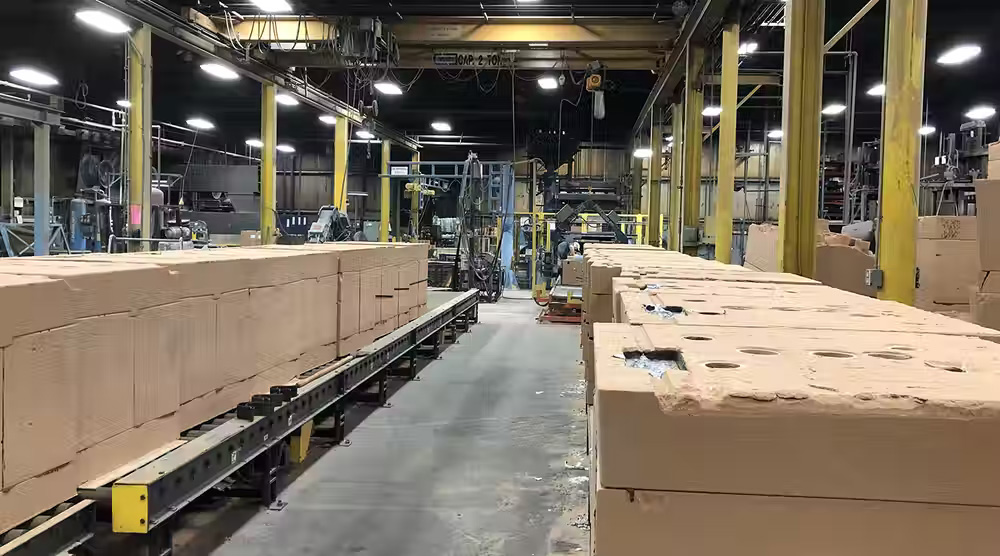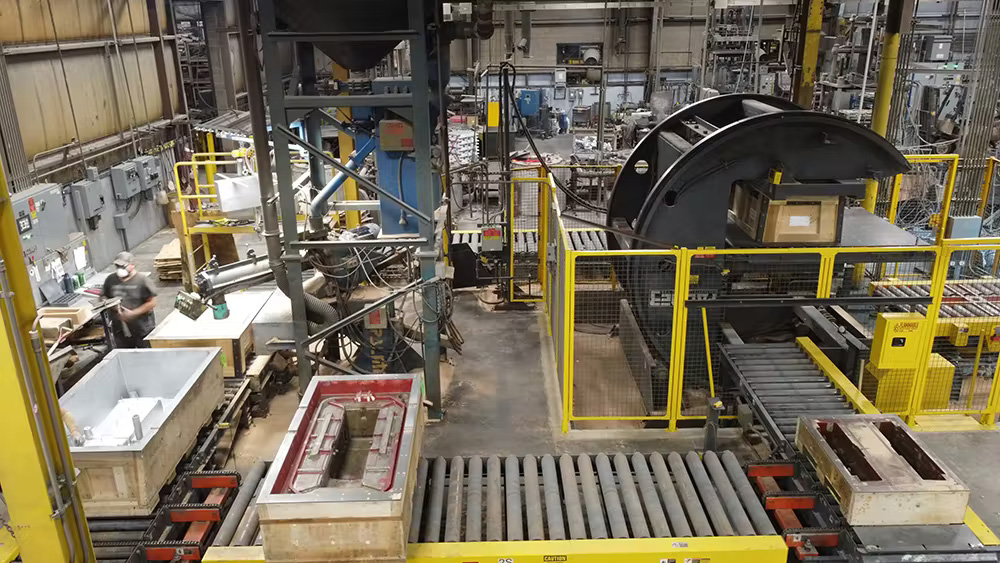Foundry & industrial processing Machinery EQUIPMENT & SYSTEMS
U.S. & Canada Call 1.800.457.5456
New No-Bake Line Cuts Handling
Home Articles New No-Bake Line Cuts Handling

Palmer Manufacturing & Supply system expands capacity, improves ergonomics, lowers production costs

An expansion program at the Wisconsin jobbing foundry has adopted automated mold-making systems to increase throughput and make production safer and more efficient.
Making castings for global aerospace, defense, and heavy-duty transportation markets sets Eck Industries apart from its competitors. The aluminum foundry in Manitowoc, WI, is committed to producing the highest quality cast parts – and its attention to detail and engineering support make Eck Industries stand out to its highly demanding customers. Among the numerous examples of this are process adjustments, even on low-volume production runs.
Eck Industries operates according to lean manufacturing principles, and the foundry also is noted for the respect it affords to its operators. The management team there included the production-floor crews early in the development process for a planned expansion to the sand mold-making operation – identifying such cooperation as a critical aspect of the project’s success.
In this situation, Eck was facing a tremendous production capacity shortage following a significant rise in new business, even requiring the plant to operate 24/7. Specifically, the foundry detailed its desire to have all the new demand for molds accomplished within the established three-shift schedule. Since most of the manual work involved molding and mold handling, Palmer Manufacturing & Supply was tasked with increasing production capacity by reducing – or eliminating – manual handling as much as possible.
"We felt strongly about increasing our production capacity to meet current and future production needs," explained Jeff Friday, v.p. Operations at Eck Industries. "Additionally, we needed a system to reduce manual handling, to increase molds per hour and reduce safety issues."
The established mold-making process involved running the existing molding line throughout all three shifts, sometimes over six days, to meet the production requirements.
As with most jobbing shops, Eck produces castings in varied amounts and with many different degrees of complexity. Some of the jobs are simple – small, cope-and-drag, no-core work – whereas other projects involve large and long castings with ram-up cores, substantial numbers of sleeves and chills needed, etc.
Planning for what’s coming
Eck’s new system needed to be designed and configured to produce this wide variety of work quickly and efficiently, with the fewest “touches” needed to discharge a quality mold at the desired production rate – while also allowing for future expansion and increased production rates because, as everyone knows, in the jobbing world you never know what’s coming through the door.
Thus, Eck put forth three key project goals:
- Reduce labor while dramatically increasing production capacity.
- Increase mold quality through automated handling (from manual handling.)
- Increase mold production.
Before Palmer could make a production proposal, an investigation and analysis with Eck needed to take place, during which we showed them many available options installed at foundries that set similar production objectives, capabilities, and capacities. We visited square-loop/transfer-car molding systems as well as foundries using flip molding and universal machine molding (FMM/UMM) automated no-bake molding systems.
While showing these different molding systems we find that quite often a customer will see things that Palmer might not have addressed directly, but that applies directly to a particular facet of the customer's production and/or equipment requirements. As the adage goes "seeing is believing."
Eck wisely included the production floor personnel in many of these visits; the operators can make or break any project, so including them in the investigative stage was especially important. Managers, supervisors, engineers, etc., understand how things should work and plan accordingly; people on the plant floor work with the system all day, every day, meaning that their opinions and ideas are experience-based, and not theoretical.
Some of our most successful projects have incorporated the production teams from the first day. These individuals become the champions for the project instead of instinctively resisting changes to their routines. Operators that fear a project will push back and make any implementation of change much more difficult.
At Eck Industries, as at most jobbing shops, the workflow involved molds for a range of casting sizes and designs. Some jobs involved simple, small cope-and-drag processes, with no core work. Others involved large and/or long molds, with loose pieces, and required placement of substantial sleeves and chills, etc. Palmer recommended a three-phase approach to this project.
Phase 1. Increasing production, decreasing manual labor
To increase production while reducing manual labor, and to increase the number of molds produced per hour, a C–frame rollover molding machine was custom designed. The rollover technique eliminates manual handling of the molds and cores, and the closing step. Also, because Eck’s work involves producing large and long castings, positioning the molding boxes sideways proved to be the most efficient layout. Filling, compacting, and moving the boxes to the rollover was accomplished by adapting a Palmer mixer and mold-handling conveyors already in place at the foundry.
Normal molds would proceed into the rollover and get drawn, and the empty box would be returned to the molding line, with the mold running straight into the coring and closing lines. Large molds would exit the rollover at 90 degrees from the correct orientation for coring and closing.

To increase ECK Industries' casting throughput while reducing manual labor, Palmer Manufacturing custom-designed a new C-frame rollover molding machine
For this reason, a customized lift–rotation device was designed and manufactured to receive the long molds. The lift would clear the surrounding conveyors and structural components, rotate 90 degrees, and then would be lowered back to the coring closing line.
To reduce manual handling further, a large scissors lift was placed strategically at the closing line to allow the mold height to be adjusted when being placed and the mold to be closed. Once the mold is cored and closed, it would continue on the system and conveyor level to be moved to the pouring area.
Phase 2. Mixing automation
While the rollover and handling equipment reduced labor (and potential injuries) and established the future option to increase the molding rate—it became apparent quickly that the mold production rate could easily be improved simply by increasing the output of the current mixer.
Any no-bake molding system production rate is predicated by the process of removing sand from the box. Whether a chain and crane is used, a mold handler to rollover and strip/assemble a conventional rollover, or the new modern UMM/FMM technology – getting the sand out of the box determines the speed of the operation. A mold box can be filled faster with a large mixer, and the coating, drying, coring, closing, and clamping steps can easily meet the higher rates by adding labor, but the draw cycle sets the pace.
The telling detail is the rollover; the rollover should always be working. If the system does not generate a filled box quickly enough then the rollover is waiting for the filled box during the time when it could be cycling.
Phase 3. Streamlining knock-out
Making the mold knock-out area more productive and efficient is the last phase of this project – still underway, with the installation planned during 2022.
This new molding system, employing various levels of automation technologies that successfully exceed all of the primary goals set by Eck Industries. includes:
- Labor demand was reduced significantly by adopting the rollover and automated mold-handling techniques, which have created a more manageable system for the foundry.
- The mold production rate has been thereby tripled very shortly after installation.
- Automated handling has increased mold quality and proven to be a safer system for the operators.
"We were extremely pleased with the results of this project regarding several critical points," Jeff Friday reported. “First, we appreciated the thorough investigation and analysis that Palmer initiated. Seeing in action several different types of automated molding solutions was beneficial to all of us, especially our floor personnel.
"We also felt strongly about increasing the production capacity to meet our increased casting demand,” he continued, “and Palmer embraced this strategic plan with advanced automated solutions that made it possible and successful."
Friday emphasized how important it has been that the new molding installation also eliminated some potential safety issues for Eck Industries. "We are always looking for safer ways to produce product and this system helped us achieve that key safety metric as well."
Jack Palmer is the president of Palmer Manufacturing & Supply, a specialty supplier of no-bake foundry equipment, including: sand mixers, molding systems, core room equipment, sand reclamation, mold handlers, pumping systems, resin heating systems, sand conditioning, compaction tables, mold and core coating equipment, and complete systems and engineering services.
Copyright © 2025 Palmer Manufacturing & Supply, Inc. | Terms and Conditions | Privacy Policy




